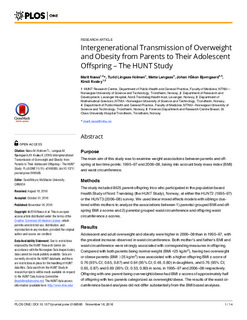| dc.contributor.author | Næss, Marit | |
| dc.contributor.author | Holmen, Turid Lingaas | |
| dc.contributor.author | Langaas, Mette | |
| dc.contributor.author | Bjørngaard, Johan Håkon | |
| dc.contributor.author | Kvaløy, Kirsti | |
| dc.date.accessioned | 2016-11-18T14:16:08Z | |
| dc.date.accessioned | 2016-11-23T14:40:19Z | |
| dc.date.available | 2016-11-18T14:16:08Z | |
| dc.date.available | 2016-11-23T14:40:19Z | |
| dc.date.issued | 2016 | |
| dc.identifier.citation | PLoS ONE 2016, 11 | nb_NO |
| dc.identifier.issn | 1932-6203 | |
| dc.identifier.uri | http://hdl.handle.net/11250/2422725 | |
| dc.description.abstract | Purpose:
The main aim of this study was to examine weight associations between parents and offspring at two time points: 1995–97 and 2006–08, taking into account body mass index (BMI) and waist circumference.
Methods:
The study included 8425 parent-offspring trios who participated in the population based Health Study of Nord Trøndelag (the HUNT Study), Norway, at either the HUNT2 (1995–97) or the HUNT3 (2006–08) survey. We used linear mixed effects models with siblings clustered within mothers to analyze the associations between 1) parental grouped BMI and offspring BMI z-scores and 2) parental grouped waist circumference and offspring waist circumference z-scores.
Results:
Adolescent and adult overweight and obesity were higher in 2006–08 than in 1995–97, with the greatest increase observed in waist circumference. Both mother’s and father’s BMI and waist circumference were strongly associated with corresponding measures in offspring. Compared with both parents being normal weight (BMI <25 kg/m2), having two overweight or obese parents (BMI ≥25 kg/m2) was associated with a higher offspring BMI z-score of 0.76 (95% CI; 0.65, 0.87) and 0.64 (95% CI; 0.48, 0.80) in daughters, and 0.76 (95% CI; 0.65, 0.87) and 0.69 (95% CI; 0.53, 0.80) in sons, in 1995–97 and 2006–08 respectively. Offspring with one parent being overweight/obese had BMI z-scores of approximately half of offspring with two parents categorized as overweight/obese. The results of the waist circumference based analyses did not differ substantially from the BMI based analyses.
Conclusions:
Parental overweight was strongly positively associated with offspring weight both in 1995–97 and 2006–08 where both parents being overweight/obese gave the largest effect. This seemingly stable association, strongly address the importance of public health initiatives towards preventing obesity in parents of both sexes to decrease further obesity expansion in offspring. | nb_NO |
| dc.language.iso | eng | nb_NO |
| dc.rights.uri | https://creativecommons.org/licenses/by/4.0/ | |
| dc.title | Intergenerational Transmission of Overweight and Obesity from Parents to Their Adolescent Offspring – The HUNT Study | nb_NO |
| dc.type | Journal article | nb_NO |
| dc.type | Peer reviewed | nb_NO |
| dc.date.updated | 2016-11-18T14:16:08Z | |
| dc.source.volume | 11 | nb_NO |
| dc.source.journal | PLoS ONE | nb_NO |
| dc.identifier.doi | 10.1371/journal.pone.0166585 | |
| dc.identifier.cristin | 1401268 | |
| dc.description.localcode | © 2016 Næss et al. This is an open access article distributed under the terms of the Creative Commons Attribution License, which permits unrestricted use, distribution, and reproduction in any medium, provided the original author and source are credited. | nb_NO |

